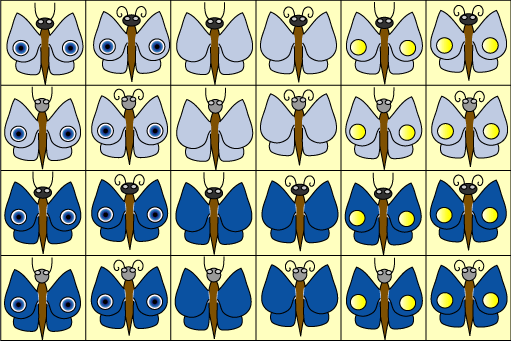Skip over navigation
Four children were sharing a set of twenty-four butterfly cards. It looked easy! They could have six each.
But it was far from easy!

First Kim said, "I like the ones with curly antennae. I want those!"
"I don't like the ones with oval heads," complained Wim, "But want all the others!"
Jim only wanted the ones with yellow spots.
Tim wanted butterflies which only had dark wings and blue spots.
"You can't have two things," complained Jim, "That's greedy! You'll get more cards!"
Do you think he was right?
Are there any cards that nobody wants?
Are there any cards that all the children want?
Are there any cards that just one child wants?
Can all the children have the cards they want?
Can you think of a fair way for them to share out the cards?
You might like to print off an A4 copy of the cards.

Or search by topic
Number and algebra
Geometry and measure
Probability and statistics
Working mathematically
Advanced mathematics
For younger learners
Butterfly Cards
Age 7 to 11
Challenge Level 





- Problem
- Getting Started
- Student Solutions
- Teachers' Resources
Butterfly Cards
Four children were sharing a set of twenty-four butterfly cards. It looked easy! They could have six each.
But it was far from easy!

First Kim said, "I like the ones with curly antennae. I want those!"
"I don't like the ones with oval heads," complained Wim, "But want all the others!"
Jim only wanted the ones with yellow spots.
Tim wanted butterflies which only had dark wings and blue spots.
"You can't have two things," complained Jim, "That's greedy! You'll get more cards!"
Do you think he was right?
Are there any cards that nobody wants?
Are there any cards that all the children want?
Are there any cards that just one child wants?
Can all the children have the cards they want?
Can you think of a fair way for them to share out the cards?
You might like to print off an A4 copy of the cards.
Why do this problem?
This problem gives learners some simple data to organise. As in many cases, there is no obvious solution. It can be done practically with the interactivity or the cards, but it can also be opened up as it can be seen from the Possible extension. It could be a good introduction into the idea of sets and Venn
diagrams.
Possible approach
This sheet gives small copies of the cards (not numbered) for individual use and these sheets have two sets of much larger cards, one set
plain and the other numbered.
You might find this interactivity useful for illustrating different solutions at the end of the lesson.
Key questions
What can you tell me about this butterfly?
Which attribute are you collecting there?
How many can you find that have Curly Antenna [Round Heads/Yellow Spots/Dark Wings/Blue Spots]?
Have you found any cards that nobody wants?
Have you found any cards that all the children want?
Have you found any cards that just one child wants?
Can all the children have the cards they want?
Can you think of a fair way for them to share out the cards?
How are you going to record what you have done?
Possible extension
Learners could sort the cards using Venn diagrams as described on this sheet.Possible support
Suggest sorting copies of the cards. These cards are quite small, while these are much larger and include the numbered cards.You may also like
Cereal Packets
How can you put five cereal packets together to make different shapes if you must put them face-to-face?

